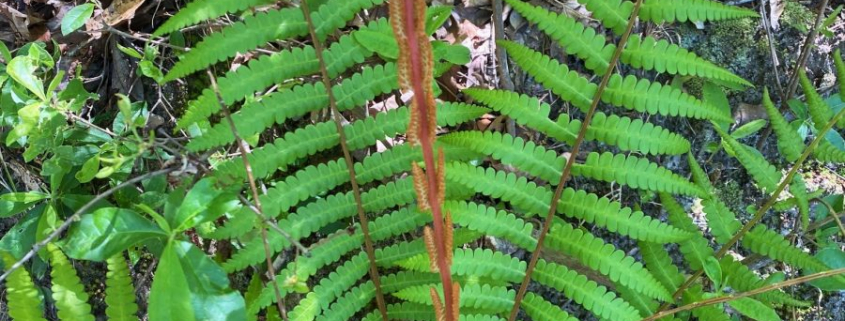April Visit to Lake Lurleen State Park: Focus on Treasures in the Forest!
April 19, 2023 I arrived about noon at Alabama’s Lake Lurleen State Park (LLSP; near Tuscaloosa), then departed mid-afternoon April 20 after a morning meeting of the Alabama State Parks Foundation Board. I focus this Post on forest treasures and delights I discovered and examined the first afternoon as I transited four-plus miles of the Lakeshore Trail.
Like all of Alabama’s state parks, trail information signage and maps mark the way. This trailhead lies within sight of the LLSP headquarters.
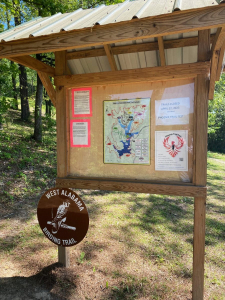
I try to record a brief video for each of my Posts. I’ve often repeated the timeless wisdom that a picture is worth a thousand words. That is the reason that from the get-go I’ve adopted the photo-essay format. I’ve learned with my trusty iPhone to move a step beyond a still photo, thus this 1:40 video, which hopefully translates to a video is worth ten thousand words!
Special Flowering Plants
I don’t recall previously see Florida anise in flower, yet it grew in relative abundance in moist shady sites along the trail. Its evergreen leaves and multi-stemmed shrub form remind me of rhododendron. The genus name (Illicium) derives from the Latin term, illici, meaning “seductive,” in reference to its scent. I found everything about the shrub seductive!
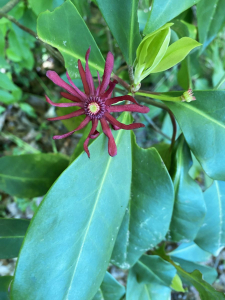
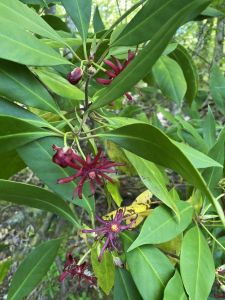
Phlox blue-brightened the afternoon. I pondered how many days a year, at any one of my favorite natural areas across the northern third of Alabama, would I find some flowering native plant in full flower. I believe that if we include the tiny open meadow bloomers, the season of flowering would extend twelve months. Compared with my winters in New Hampshire, Upstate New York, Ohio, New Hampshire, Pennsylvania, Western Maryland, and Alaska, I stand by my long-held conclusion that our Alabama autumns slowly transition to spring, with a few cold days tossed in time-to-time to add spice with the illusion of winter. However, of great import to me, we do enjoy the period mid-November through early April without forest crown foliage. I cherish dormancy, even if mild weather prevails.
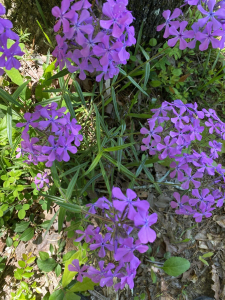
Little brown jugs (heart-leafed ginger) is a native evergreen perennial common to rich hardwood forests. Its main ornamental feature is its mottled leaf surface and burgundy underside. Its brown, jug-shaped flowers lie hidden under its leaves.
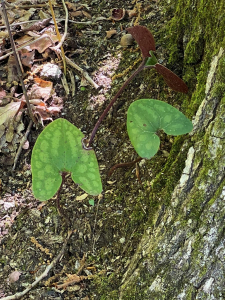
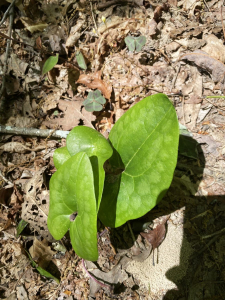
Although I did not find the brown jug flowers, this is a flowering plant, thus its inclusion under the heading.
Ferns and Lichens
I’ve always been a big fern fan. I have two long-term favorites: interrupted and cinnamon fern, both of which we cultivated in abundance in our New Hampshire perennial beds. I don’t recall seeing interrupted fern here in the South. In fact, I just checked, finding that the species range stays well north of us. I love the cinnamon fern’s singular fertile frond standing at the center of its circle of attractive vegetative leaves.
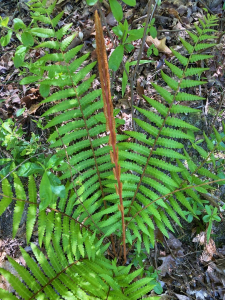
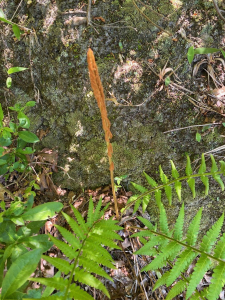
At first glance I identified this fern as “sensitive,” however iNaturalist identified it as netted chain fern. The leaf margins distinguish the two. I am satisfied that iNaturalist is correct.
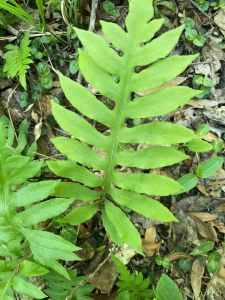
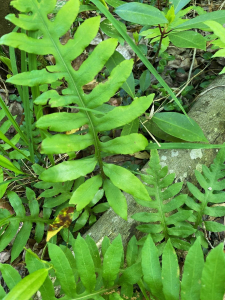
I recall traveling a dozen years ago from Rovaniemi, Finland (on the Arctic Circle) north into Lapland, where native Sami have tended reindeer and managed reindeer lichens for centuries. Herders rotate their animals across fenced lichen-rich northern forests to keep lichen grazing at sustainable levels. The dixie reindeer lichen colonies below reminded me of the Lapland reindeer forests. My trip north into Sami country, then west through northern Sweden, then over and along the fjords of Norway provided stunning scenery, provocative geography and ecosystem diversity, and one of the most memorable international experiences of my career. Nature for me is an unmatched physical evocator of powerful memories.

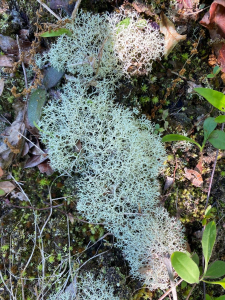
Ferns and lichens, elements of an intriguing forest ecosystem, drawing my attention, spur me to learn more, and transport me to deeply pleasant memories!
Tree Form Curiosities and Oddities
Always on alert for tree form oddities and curiosities, I discovered an American beech that did not disappoint. Hollow from some past injury and subsequent decay, this tree allows light to pass from one side to another. Its cambial rind is sufficient to support the tree’s mass, i.e. its trunk and full crown (right), and faithfully conduct carbohydrates, sugars, and water within the tree.
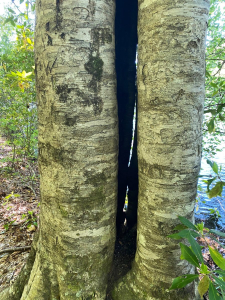
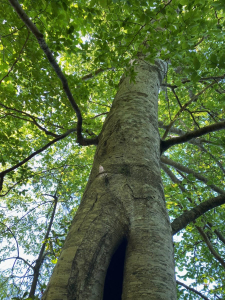
The trailside stilted sweetgum likewise encourages light to pass from one side to the other. I can’t offer a definitive explanation for this curiosity. Here is my best shot. Picture an old stump topped with decaying wood and accumulated organic matter, thick enough to germinate a sweetgum seed. The stump continues to decay as the seedling grows, eventually extending its roots along the stump iside into the soil. The original stump has long since fully decayed; the sweetgum roots now serve as stilts.
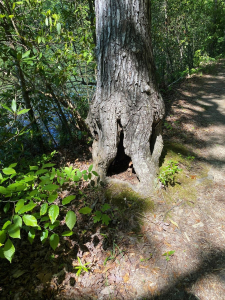
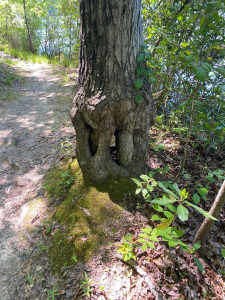
I am about to make a statement of universal truth…so obvious, in fact, that I have never bothered to include it explicitly in one of my prior 350-plus Posts. Within any developing forest, say here in our northern Alabama temperate region beyond age 25-30 years, heavy things (branches or entire trees) occasionally fall, often hitting other standing live trees. When slammed just right by those heavy objects, a still somewhat flexible live tree bends and may not break. The bent tree remains alive, even when its then living crown is snapped, as in this sweetgum tree (photos below). Responding to its bent-over condition, this sweetgum sprouted new vertical shoots from adventitious buds, sending them into the intermediate canopy. So often people well-intentioned attribute such manifestations to the intentional action of Native Americans to create Indian marker trees pointing the way to some landscape feature.
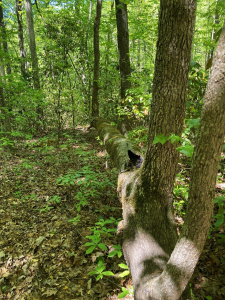
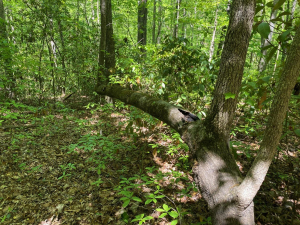
Allow me to disabuse you of any such notion. This particular sweetgum tree is no more than 90 years old, having sprouted into life a full century after most Native Americans relocated (voluntarily or otherwise) from our state. A Native American marker tree — no. A natural phenomenon — yes!
Burrowing Crayfish and Green Snakes
The trail weaved generally through uplands with an occasional dip into wet areas along the shore. The wetter soils provide habitat for saturated-ground-dwelling crawdads (burrowing crayfish) that live below ground in excavated hollows, connected via vertical outlets to the surface. The crayfish lift balls of mud from their burrows, piling them into vertical passageways (left) with a clear exit hole (right).
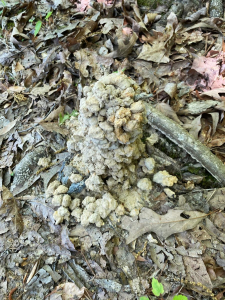
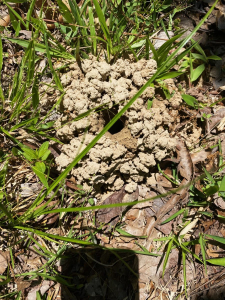
I found an online document on burrowing crayfish at the Missouri Department of Conservation website:
These burrowing crayfish are called “ecosystem engineers.” Like beavers, who modify and build habitats to better suit their needs, crayfish modify their surrounding environment, create a specialized role for themselves, and often provide habitat for other animals and plants. Burrowers often excavate and inhabit tunnels (burrows) near surface water like streams, ponds, marshes, and even human-made ditches. They dig down into the soil until they reach the water table and use underground water for moisture and breathing.
I’m always on the lookout for fascinating features.
I nearly stepped on this rough greensnake, an attractive principally arboreal non-venomous forest inhabitant. The species typically consumes insects and small lizards that it finds in tree canopies.
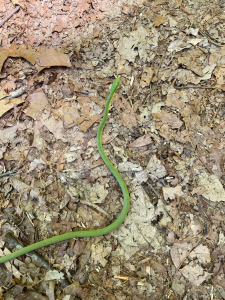
I felt blessed to discover it at my feet!
Combined with burrowing crayfish, a stilted tree, cinnamon fern, and seductive anise, the greensnake served as a cherry topping on a sundae of Nature delights. I entered the forest seeking none of these especially, yet I found all of them and more. Nature never disappoints those willing to believe surprises await, capable of looking with purpose, open to actually seeing what lies hidden within, and acceptable to feeling the joy of immersing in all things natural.
Alabama State Parks Foundation
Thoughts and Reflections
I offer these observations:
- Even a four-mile forest saunter opens windows into deep mysteries and special wonders.
- And into the forest I go, to lose my mind and find my soul. (John Muir)
- What could be more rewarding than an afternoon encountering a tree on stilts, a rough green snake, and a burrowing crayfish!
Inhale and absorb Nature’s elixir. May Nature Inspire, Inform, and Reward you!
Note: All blog post images created & photographed by Stephen B. Jones unless otherwise noted. Please circulate images with photo credit: “©2023 Steve Jones, Great Blue Heron LLC. All Rights Reserved.”
Another Note: If you came to this post via a Facebook posting or by an another route, please sign up now (no cost… no obligation) to receive my Blog Post email alerts: http://eepurl.com/cKLJdL
And a Third: I am available for Nature-Inspired Speaking, Writing, and Consulting — contact me at steve.jones.0524@gmail.com
Reminder of my Personal and Professional Purpose, Passion, and Cause
If only more of us viewed our precious environment through the filters I employ. If only my mission and vision could be multiplied untold orders of magnitude:
Mission: Employ writing and speaking to educate, inspire, and enable readers and listeners to understand, appreciate, and enjoy Nature… and accept and practice Earth Stewardship.
Vision:
- People of all ages will pay greater attention to and engage more regularly with Nature… and will accept and practice informed and responsible Earth Stewardship.
- They will see their relationship to our natural world with new eyes… and will understand more clearly their Earth home.
Tagline/Motto: Steve (Great Blue Heron) encourages and seeks a better tomorrow through Nature-Inspired Living!
Steve’s Three Books
I wrote my books Nature Based Leadership (2016), Nature-Inspired Learning and Leading (2017), and Weaned Seals and Snowy Summits: Stories of Passion for Place and Everyday Nature (2019; co-authored with Dr. Jennifer Wilhoit) to encourage all citizens to recognize and appreciate that every lesson for living, learning, serving, and leading is either written indelibly in or is powerfully inspired by Nature.
I began writing books and Posts for several reasons:
- I love hiking and exploring in Nature
- I see images I want to (and do) capture with my trusty iPhone camera
- I enjoy explaining those images — an educator at heart
- I don’t play golf!
- I actually do love writing — it’s the hobby I never needed when my career consumed me
- Judy suggested my writing is in large measure my legacy to our two kids, our five grand kids, and all the unborn generations beyond
- And finally, perhaps my books and Blogs could reach beyond family and touch a few other lives… sow some seeds for the future


All three of my books (Nature Based Leadership; Nature-Inspired Learning and Leading; Weaned Seals and Snowy Summits) present compilations of personal experiences expressing my (and co-author Dr. Wilhoit for Weaned Seals and Snowy Summits) deep passion for Nature. All three books offer observations and reflections on my relationship to the natural world… and the broader implications for society. Order any and all from your local indie bookstore, or find them on IndieBound or other online sources such as Amazon and LifeRich.

